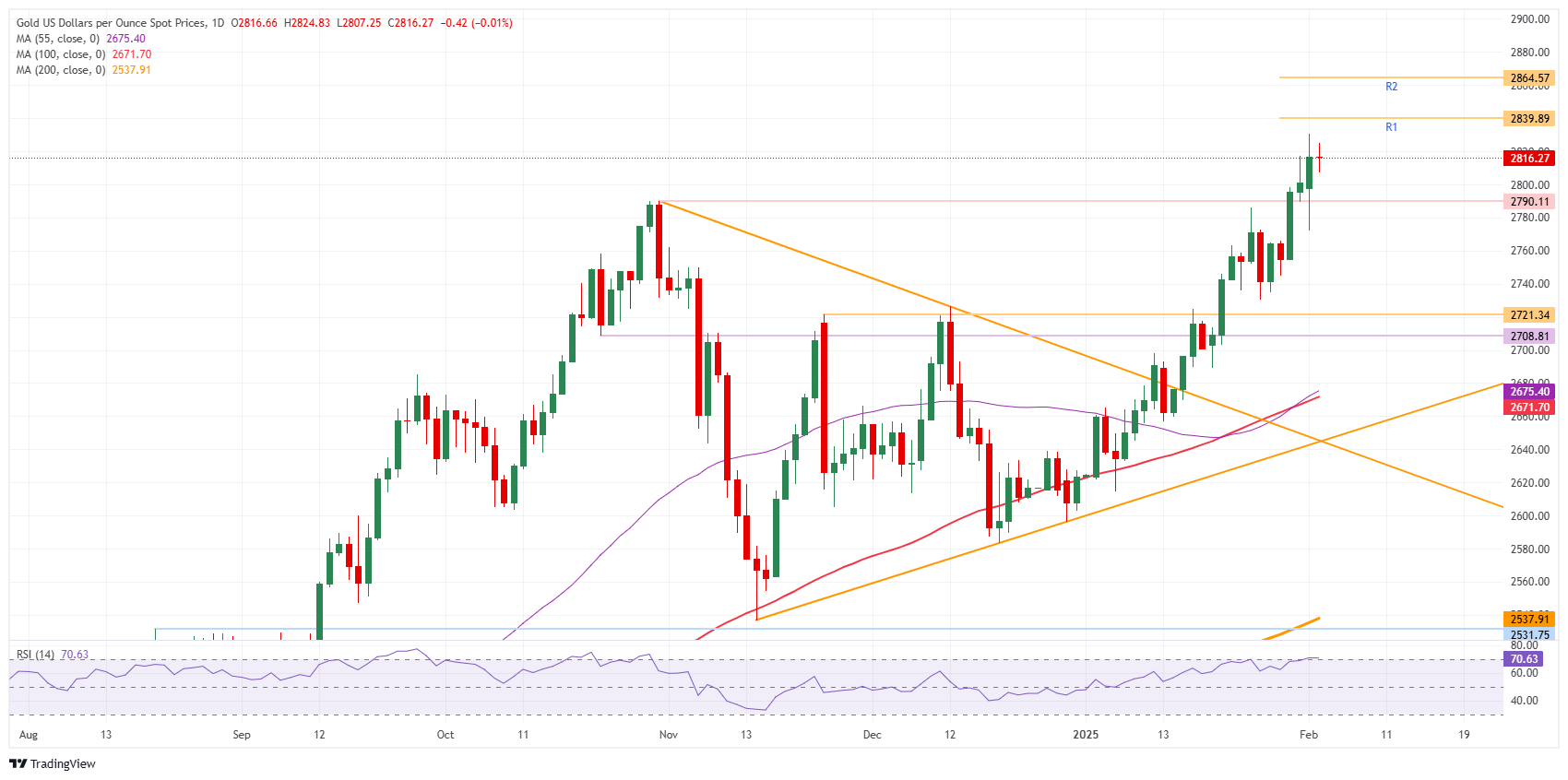Gold consolidates as US-China trade war fears escalate
- Gold printed a fresh record high at $2,830.70 on Monday.
- China retaliates and issues tariffs on US imports as countermeasures.
- Gold faces stretch intraday resistance levels due to the volatile move on Monday.
Gold’s price (XAU/USD) consolidates its recent move to new all-time highs and looks for direction on Tuesday after China retaliated against US tariffs issued over the weekend. Beijing imposed a 15% tariff on less than $5 billion of US energy imports, such as Coal and Liquified Natural Gas (LNG), and a 10% fee on American Oil and agricultural equipment. It will also investigate Google for alleged antitrust violations. Markets are unclear on what to do with these retaliatory tariffs and are showing whipsaw patterns on Tuesday’s price action.
On the economic data front, the calendar is light ahead of the runup to the Nonfarm Payrolls report, scheduled on Friday. On Tuesday, the JOLTS Job Openings for December could be of interest later in the day, followed by two Federal Reserve (Fed) speakers, Atlanta Fed Raphael Bostic and San Francisco Fed Mary Daly.
Daily digest market movers: Tit for tat
- China retaliated to US President Donald Trump’s opening trade war tariffs by targeting a handful of American companies and slapping levies on some US goods, in a move seemingly designed to avoid escalating tensions between the world’s two biggest economies, Bloomberg reports. China's response was seen as "measured and appropriate" and "targeted to send Trump a warning without hurting its own access to important commodities."The tariffs are set to kick in on February 10, potentially leaving room for negotiation.
- At 15:00 GMT, the December JOLTS Job Openings report is due. Expectations are that there will be a decrease to 8 million job openings, down from 8.098 million in November.
- At 16:00 GMT, Atlanta Fed President Raphael W. Bostic moderates a conversation with Atlanta Mayor Andre Dickens at a National Housing Crisis Task Force meeting in Atlanta.
- At 19:00 GMT, Federal Reserve Bank of San Francisco President Mary Daly will participate in the Walter E. Hoadley Annual Economic Forecast panel, hosted by the Commonwealth Club World Affairs of California.
- The CME FedWatch tool shows an 86.5% chance of keeping interest rate unchanged in the March 19 meeting, compared to 13.5% for a 25 basis points rate cut.
Technical Analysis: Choppyness begins
This is where the boys will be separated from the men in trading after China counteracted on Tuesday President Trump’s tariffs slapped over the weekend. Whipsaw moves and headline-driven volatility will take over the logic price action from here on out. Stay loyal to the bigger levels, which will act as support or resistance intraday and in the longer term.
The first support comes in at the $2,800 round level, followed by $2,790, which was November’s high. The low of Monday in the chaotic opening of this week at $2,772 should act as the next support. Once that level should snap, a quick sprint to $2,721 could be underway.
Analysts and strategists have called for $3,000, but the region around $2,800 looks like a good starting point for profit-taking. Based on Monday’s price action, technical analysis (pivot points) shows $2,839 and $2,864 as the next daily resistance levels. These will become important, along with the logic big figures such as $2,850 and $2,880.
XAU/USD: Daily Chart
Gold FAQs
Gold has played a key role in human’s history as it has been widely used as a store of value and medium of exchange. Currently, apart from its shine and usage for jewelry, the precious metal is widely seen as a safe-haven asset, meaning that it is considered a good investment during turbulent times. Gold is also widely seen as a hedge against inflation and against depreciating currencies as it doesn’t rely on any specific issuer or government.
Central banks are the biggest Gold holders. In their aim to support their currencies in turbulent times, central banks tend to diversify their reserves and buy Gold to improve the perceived strength of the economy and the currency. High Gold reserves can be a source of trust for a country’s solvency. Central banks added 1,136 tonnes of Gold worth around $70 billion to their reserves in 2022, according to data from the World Gold Council. This is the highest yearly purchase since records began. Central banks from emerging economies such as China, India and Turkey are quickly increasing their Gold reserves.
Gold has an inverse correlation with the US Dollar and US Treasuries, which are both major reserve and safe-haven assets. When the Dollar depreciates, Gold tends to rise, enabling investors and central banks to diversify their assets in turbulent times. Gold is also inversely correlated with risk assets. A rally in the stock market tends to weaken Gold price, while sell-offs in riskier markets tend to favor the precious metal.
The price can move due to a wide range of factors. Geopolitical instability or fears of a deep recession can quickly make Gold price escalate due to its safe-haven status. As a yield-less asset, Gold tends to rise with lower interest rates, while higher cost of money usually weighs down on the yellow metal. Still, most moves depend on how the US Dollar (USD) behaves as the asset is priced in dollars (XAU/USD). A strong Dollar tends to keep the price of Gold controlled, whereas a weaker Dollar is likely to push Gold prices up.

